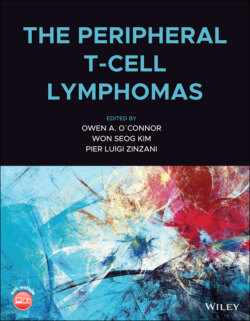Читать книгу The Peripheral T-Cell Lymphomas - Группа авторов - Страница 15
General View of the Differentiation and Function of T Lymphocytes
ОглавлениеThe immune system can be classified into two basic component: (i) the innate immune system, and (ii) the acquired immune system. The innate immune system is considered to be relatively agnostic to any specific antigen, and is often described as invariant. The innate immune response is the first line of defense, and typically exhibits limited specificity. Examples of innate immune response may include phagocytosis by macrophages, barriers to infection provided by the skin and tears, natural killer and mast cells, and complement‐mediated cytolysis. In contrast, the adaptive (or sometimes called acquired) immune response develops in response to specific antigen, being “custom” designed for the antigen in question. It usually occurs later in the immune response, and has the ability to recall the response to past infections. Components of a functioning acquired immune response might involve antigen‐presenting cells presenting antigen or T cells, the activation of specific T cells which would signal to B cells enlisting their engagement in the response and the production of highly specific antibody capable of binding specific antigen. T and B lymphocytes are the major types of lymphocytes found in the human body, where they can constitute 20–40% of all white blood cells, with only about 2–3% being found in the peripheral circulation, the remainder being localized to various lymphoid organs (lymph nodes, spleen, submucosal tissue). Remarkably, the total mass of lymphocytes in the body can approximate the mass of the brain and liver.
As shown in Figure 1.1 [1], T lymphocytes arise from a bone marrow precursor, which undergoes maturation and functional orientation in the thymus. Antigen‐specific T cells mature in the thymic cortex, where the elements recognizing self‐peptides and major histocompatibility antigens expressed by cortical epithelial cells and thymic nurse cells are eliminated via apoptosis. Failure to eliminate those T cells recognizing self‐peptides is thought to give rise to a host of autoimmune disorders.
Figure 1.1 Schematic overview of T‐cell ontogeny and differentiative trajectories.
Source: Claudio Tripodo, Stefano Pilleri.
Cortical thymocytes exhibit an immature T‐cell phenotype and express a characteristic repertoire of proteins including TdT, CD1a, CD3, CD5, and CD7. CD3 is expressed in the cytoplasm until completion of T‐cell receptor (TCR) gene rearrangement and is then exported to the cell membrane. Cortical thymocytes are initially CD4/CD8 double negative.
Medullary thymocytes exhibit a phenotype similar to that of mature T cells of the peripheral lymphoid organs with segregation of CD4 and CD8 antigens. Based on the structure of the variable portion of the TCR, T cells have been divided into two classes, including alpha/beta and gamma/delta T cells. They are both associated with the CD3 complex, which contains gamma, delta, and epsilon chains. Gamma and delta T cells usually lack expression of CD4, CD8, and CD5, although a subpopulation can expresses CD8. They represent less than 5% of normal T lymphocytes and are primarily located in the splenic red pulp, intestinal epithelium, and other epithelial sites. They also have a restricted range of antigen recognition and take part in the innate immune reaction, serving as a first line of defense against bacterial peptides. They are often involved in responses to mycobacterial infections and in mucosal immunity. T lymphocytes of the adaptive immune system, which are heterogeneous and functionally complex, include naïve, effector (regulatory and cytotoxic), and memory T cells.
CD4+ T cells are primarily regulatory in nature. Based on their cytokine secretion profiles, they are divided into two major types: T helper (Th) 1 cells and Th2 cells. Th1 cells secrete interleukin (IL) 2 and interferon gamma, while Th2 cells secrete IL4, IL5, IL6, and IL10. Th1 cells provide help mainly to other T cells and macrophages, whereas Th2 cells provide help mainly to B cells in antibody production. CD4+ T cells can both help and suppress immune responses and consist of multiple subpopulations. Recent studies have shown overexpression of the transcription factors TBX21 (also known as T‐bet) and GATA3 in Th1 and Th2 lymphocytes, respectively.
T regulatory (Treg) cells suppress immune responses to cancer and limit inflammatory responses in tissues. These CD4‐positive cells, which are thought to play an important role in preventing autoimmunity, express a high density CD25 and the transcription factor FOXP3. Th17 lymphocytes correspond to a subset of CD4+ effector T cells, characterized by expression of the IL17 family of cytokines, and play a role in immune‐mediated inflammatory diseases and other conditions. Recently, there has been a rapidly evolving literature around a unique CD4+ T‐cell subset that takes part in the natural functions of normal germinal centers. These cells, called T follicular helper (Tfh) cells, support B cells in the context of the germinal center reaction. They reveal a distinctive phenotype with expression of the germinal center markers BCL6 and CD10 together with CD57, ICOS and CD279/PD1 and produce the chemokine CXCL13 as well as its receptor CXCR5. CXCL13 causes proliferation of follicular dendritic cells and facilitates the migration of B and T lymphocytes expressing CXCR5 into the germinal center.
